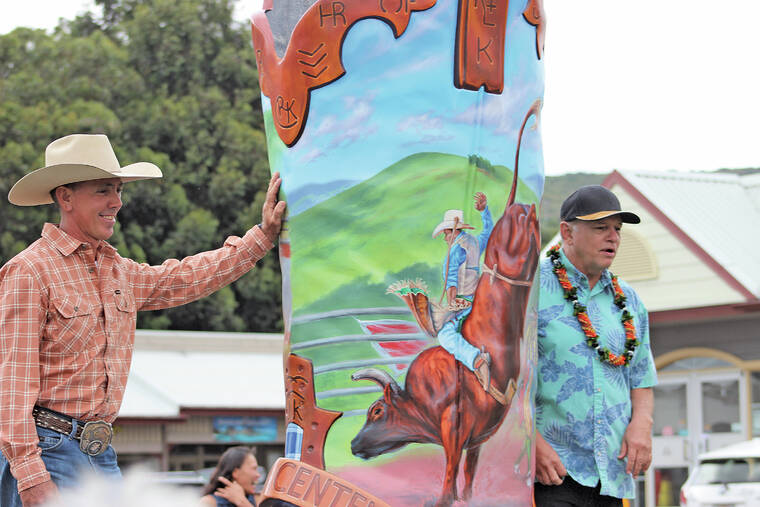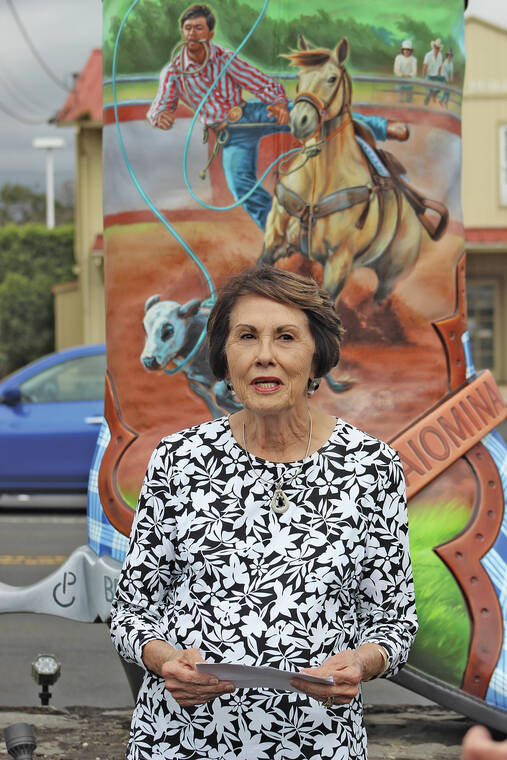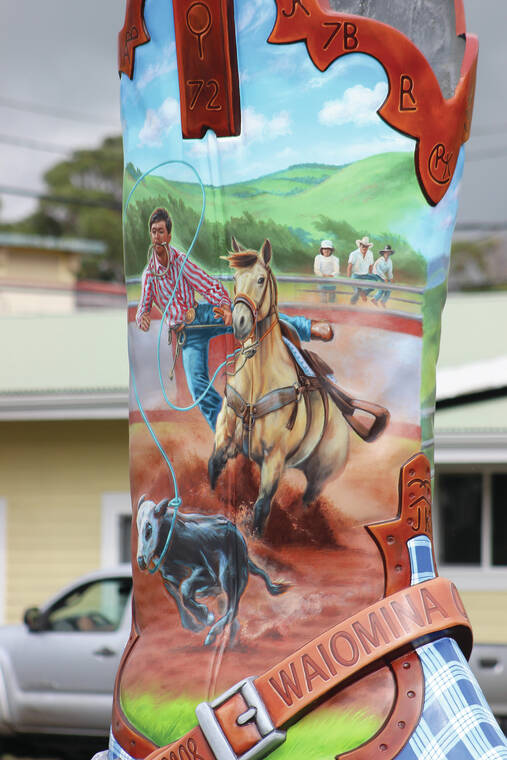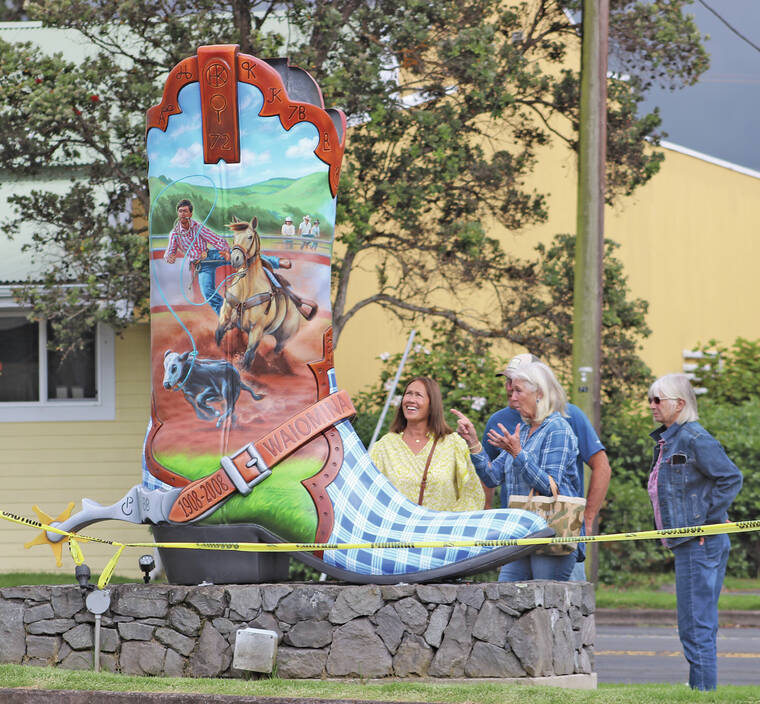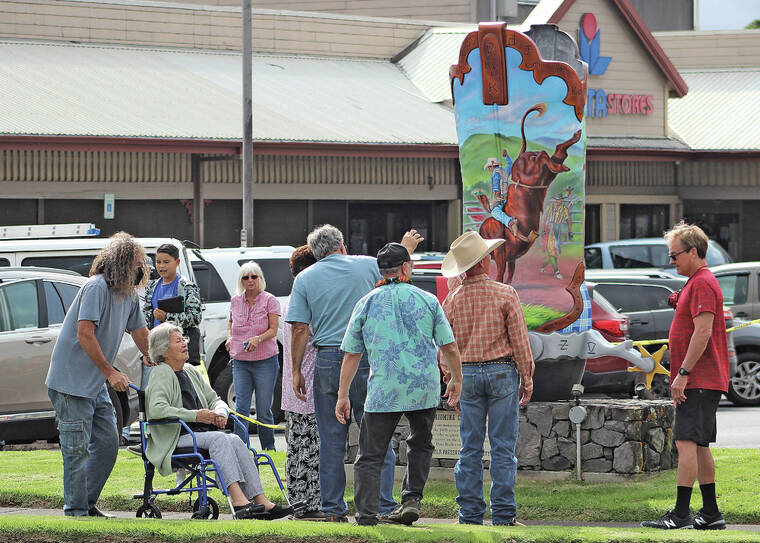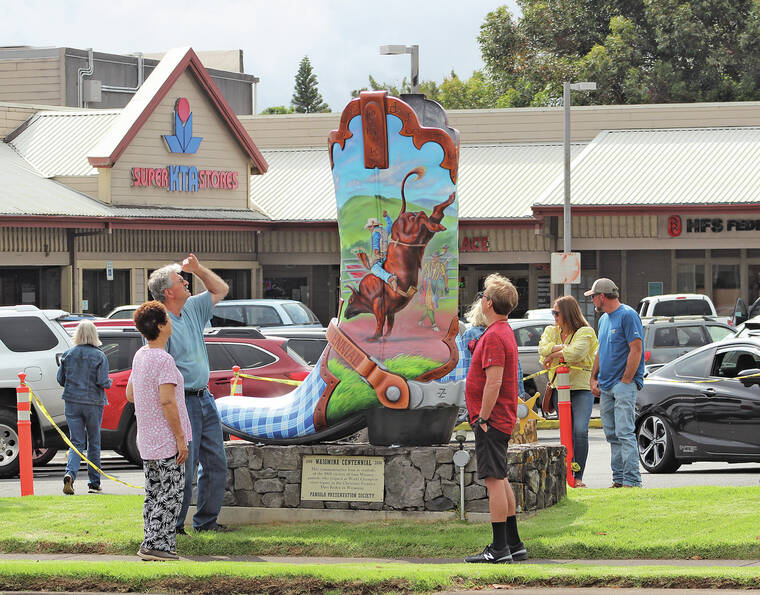Back in its place Wiaomina Centennial boot gets some TLC
Waimea’s iconic Waiomina Centennial boot is looking good once again following a nearly month-long restoration and redesign that captures even more of the area’s paniolo heritage.
The colorful cowboy boot was returned to its pedestal along Mamalahoa Highway fronting the Waimea Center Thursday afternoon with about two dozen people turning out to see the new take on the old boot.
Standing over 8 feet in height, the Paniolo Preservation Society installed the boot in late 2008 in the wake of the statewide Great Waiomina Centennial Celebration commemorating the 100th anniversary of Hawaii’s most famous paniolo, Ikua Purdy, winning the steer roping contest at the Cheyenne Frontier Days Rodeo in 1908.
The fiberglass boot was among 80 that were created by the Cheyenne Depot Museum Foundation and installed around Cheyenne for the 2008 festivities in Wyoming.
Pat Bergin, president of the nonprofit Paniolo Preservation Society, was among the delegation that traveled from Hawaii to Cheyenne that year to celebrate the centennial. While there, she found the city’s art installations intriguing and felt one would be perfect for Waimea, Purdy’s home and where the paniolo heritage still thrives.
“When we were there, I noticed all of these boots in different locations in town, and I noticed that they were all (decorated) different so I asked them, ‘how do you do this,’ and they said they happened to have one blank one left, and I said to Billy, ‘let’s take one back if we can,’ and so that’s what we did,” Bergin recalled.
The original boot was designed and painted by a renowned Colorado artist and featured images and motifs focused on the ranching traditions of Hawaii, including the “palaka” pattern on the boot’s toe.
“She hired Ross Lampshire (to do the art) and he put a bronc rider on one side and a bull rider on the other,” recalled Pat’s husband, Dr. Billy Bergin, who was also among the founding members of the Paniolo Preservation Society in 1998. “But they were almost whimsical illustrations whereas what he’s done is accurate to history.”
The work Billy Bergin is referring to was completed by renowned Hawaii artist Patrick Ching, whom the couple and society commissioned to lead the restoration with the help of Harry Wishard, Tommy Mehau and other local artists.
“We relied on Patrick because he is a rodeo competitor himself, he’s a bull rider, and we also think he does excellent work,” said Pat Bergin. “we have one of his paintings here in our home, we’ve always admired his work.”
Ching is a lifetime nature artist who hails from Oahu, though his mother is from Holualoa and his daughter, Kawena, grew up in Waimea and recently graduated from Parker School. His recent murals can be viewed at the Hawi Post Office, Kohala Hospital’s emergency room waiting area and an Alala in Hilo. He also hosts “Painting in Paradise” on Spectrum OC16.
Though much of his work focuses on birds and other wildlife, Ching is also known for his intricate paintings of horses and bulls and is a former bull rider, as well.
“It’s a celebration of the Hawaiian cowboys — the paniolo — especially the rodeo aspect of it,” Ching said of his work on the boot. “I just want them to feel good looking at a picture and want them to learn about the history of the cowboys in Hawaii. A lot of people don’t know we have rodeos or cattle or horses or anything out here.”
With the help of the Bergins, Ching perused scores of photographs to find the two images that now adorn the commemorative boot.
“I looked through lots and lots of photographs,” said Ching, “and they (the Bergins) had a photograph that looked really nice of their son, Holi, just calf roping, dismounting from his horse. It’s just a moment that catches lots of different actions going on at the same time and it was a real strong design for the art on the boot with the angles of the animal, the colors and the action.”
Holi, who tragically died in a car accident at the age of 25, adorns the boot’s Waimea Center side. On the side facing Maunakea, is a depiction of a photo by Christy Lassiter of champion bull rider Dusty Miranda on a bull named Arthur. Both images were originally captured at Parker Ranch Arena.
In addition, Ching was sure to include local ranching brands along the top of the boot, and the “palaka” fabric pattern so commonly worn by paniolo.
“One of the hardest parts of the design was the cloth on the toe and heel of the boot. It’s called ‘palaka’ and it’s kind of a traditional Hawaiian checkered pattern,” he said. “It was one of the hardest things to paint because it had a lot of lines and measurements, and they’re not just squares, they’re alternating widths and everything.”
In early July, the physical work got underway with the removal of the iconic boot from the shopping center. After 14 years in the Waimea rain and wind, the boot was due for a revamp.
“I believe that if you put something up in a community that you should maintain it and make sure it’s in a pristine state. And I felt that the original one was tired and needed some work and so we the easiest thing to do was strip it and do it all over again,” said Pat Bergin.
Once the boot was safely back at a barn on the Bergin’s property, auto body repairman and painter David Benevides stripped the peeling clear coat and old paint and prepped the fiberglass boot for its new look.
After that, Ching served as the “artist-in-residence” at the Bergin home in Waimea for 25 straight days. Each morning, he would get up early, spening the daylight hours tucked away in Bergin’s barn working his acrylics into a masterpiece.
“He worked 12 hour days, and I mean every day — Saturday and Sunday,” recalled Pat Bergin.
She hopes the revamp of the centennial boot will inspire the community to embrace Waimea’s paniolo heritage.
“We need to educate our community on what it’s like — what the paniolo lifestyle is about. I feel by putting art in public places that’s where the young people will appreciate the culture of this community forever,” she said, adding “that’s the exact reason why we founded the Paniolo Preservation Society — it’s to educate people and have people be able to come and view some of the history and we hope that it will perpetuate paniolo culture for a long time to come.”
The Paniolo Preservation Society plans to hold its fundraising Heritage Dinner and Auction this year following a two-year COVID-induced hiatus. The festivities are slated for Oct. 29, and while it’s being called a “Masquerade Ball,” Pat Bergin said the in-person event “will be an opportunity to dress up in your Western finery.”
For more information on the Paniolo Preservation Society, visit paniolopreservation.org, or visit the Heritage Center and store at Pukalani Stables in Waimea.

